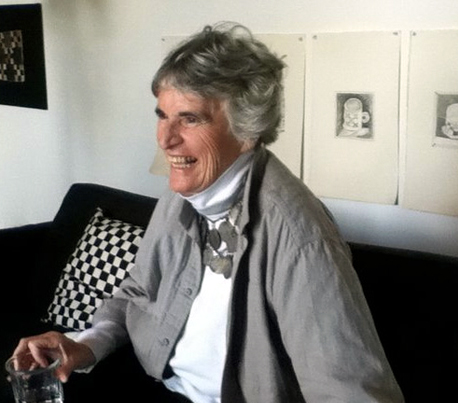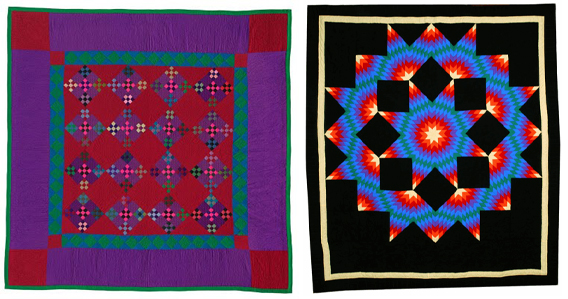
Location: Berkeley, CA
Age: 78
Marital Status: Married
Education: B.A. from Simmons College, M.A. in teaching from Harvard
Three decades ago, when Sue Bender was in her late 40s, she left her comfortable home in Westchester to live with the Amish for one month.
The experience changed her life so profoundly that she wrote a book about it, Everyday Simple: A Woman’s Journey to the Amish, which became a best-seller. Since then, Sue’s gone back to visit six more times, and she’s spoken to people all over the country, hoping to impart to them a modicum of the Amish wisdom that helped her so much. And she’s published two more books on the subject, Everyday Sacred: A Woman’s Journey Home, and Stretching Lessons: The Daring that Starts from Within.
But Sue does not consider herself a role model. Nor does she like to be called a guru. Heck, if it were up to Sue, she wouldn’t even be called a writer. We chatted with Sue and learned the perils of labels, and thinking you have all the answers. And how to make peace with your paradox.
(Note: In order to protect the privacy of the people Sue has visited and stayed with, she has kept secret the who and where particulars of her pilgrimages.)
What were you doing before you first went to stay with the Amish?
I was a ceramic artist living in New Rochelle, NY. At the time, I was having my first important show in East Hampton, Long Island, and I was very nervous about it. One day I took a break and went walking around the neighborhoods out there. I saw these amazing quilts on the wall of a small shop. I felt my heart stop pounding. I said, “Who made those quilts?” And the man there said, “The Amish.” That’s how it began. I went back almost every day and looked at the quilts. Every time I looked at them, I got calm.
What was so special about the quilts?
They were very simple. Very stoic. Just a big square with two different colors on it. Or a diamond. Very simple geometric patterns. And beautiful colors.

And you wanted to visit the people who made them?
That’s right. At the time, I had no idea that I was on a journey to change my life.
Were you looking to change your life?
At the time, I thought I had nothing to complain about. I had a good husband of many years. Two good sons. And I had a career. There was no reason for me to be desperate. All of this came as a surprise.
Looking back, can you make more sense of it?
Yes. It took the years of writing Plain and Simple to realize that my soul had been starving. This mysterious inner voice was trying to make sense of my life. I didn’t ever think I’d leave my family for three weeks to live with the Amish. And I never planned on or even dreamed of writing a book. I was learning to trust that voice inside that doesn’t seem to make sense.
How long was your first visit with the Amish?
The first time, I was planning to go for three weeks, and I was so smitten that I didn’t want to go home. I asked if I could stay another week. They said yes; my husband said yes.
Did your husband ever go with you?
I didn’t want my husband to go. He understood that this was something I wanted to do for myself. Near the end he’d come and pick me up.
What was a typical day like?
Each day was the same. Twelve of us gathered in the living room, knelt, and said a short, five-minute prayer. Then we worked—canning the peas, mowing the lawn, feeding the animals, quilting, doing the laundry—a long list. Except there was no separation between work and play. It was all ordinary, all sacred. Each thing was done with care. And without any labor-saving devices, time felt abundant. The day ended the same way it began, with the prayer.
What did you like about it so much?
I felt like Alice in Wonderland. It wasn’t their clothes being different, or that the men didn’t shave. It was that they didn’t rush. They moved through their days unhurried. For me, that was amazing. Because I was always rushing and always felt I didn’t have enough time. But I don’t even think they had a clock. They were always in the moment, which was deeply satisfying.
So there’s no Amish rat race, so to speak.
Everyone works, and all work is valued. And valued equally. There isn’t a pecking order in their society. For instance, they didn’t even have a word for artists. The people who made those quilts—they sewed and cooked and hung laundry and quilted and canned food—so there was no labeling. One time I was talking to the grandmother in the family I was with and saying how extraordinary it was. She said, “Sue, when you’re making a vegetable soup, it’s not right for the carrots to say, “I taste better than the peas. It takes all the vegetables to make a good soup.” That’s the heart of what began to nourish me. No pecking order. Women’s work mattered. They never said the word “I”—they always said “we.” And I began to see the power of limits.
The power of limits? It seems like in our society, we like to instruct people to ignore their so-called limits.
We need balance. I had been drowning in choices. I always made these lists of things to do. I was endlessly thinking, “What should I do?” and going back and forth and so on. By the end of the day, there’d be so many things, taking up the whole page, and of course I didn’t do half of them. The Amish made one big choice, which was to lead a godly life and to be stewards of the land and to be a good community. I was brought up to be special, but I ended up falling in love with the people who valued being ordinary. The simplicity and the quiet, and the clear priorities and the appreciation of everything and everybody—it was so nourishing. It was extraordinary in its ordinariness.
What inspired you to write a book about your time there?
One day, while I was churning butter, living with the Amish, that inner voice said, “Now it’s time to tell the story.” I said, “What story do you want me to write? About washing the dishes?” It seemed so strange to me. It became one of my intentions to tell an audience out there to trust that voice, to listen to the whispers of your spirit. It is trying to make sense of your life. It can be living in the tiniest shift.

Why do you think the simple, Amish way of living resonated with you so much?
In ceramics, I always made handmade, crooked, simple ceramics in black and white. I was never tempted to use the wheel. But they made me happy to make. So I had had that instinct of authenticity. And the Amish are people who don’t try to be something they aren’t.
How do you keep the Amish spirit alive when you’re back in so-called modern life?
For one thing, as a result of living with them, I’ve ended up only wearing black and white. They can be designer clothes, but they’re simple black and white. And a touch of red once in a while. It’s easier to pack. That grew out of wanting to be freed from drowning in choices.
But mostly, it’s been a series of tiny steps. The power of a pause. Seeing with fresh eyes things I’ve taken for granted. In Everyday Sacred, I tell the story of a cappuccino maker at a cafe near where I once worked. No matter how long the line was, no matter how many people were waiting, he’d take time to make a smiling face in the foam. I had seen that smiling face so many times, but I had never appreciated what a lovely ritual that was.

Is it possible to live the simple, slower life but also be tapped into the modern life?
It is, but it’s not easy. When I came home, it was very hard to live what I had learned at first. I knew there was something inside me. I didn’t doubt that. But I didn’t know how to translate it into my everyday life. I was full of doubts. One day my son saw me zooming around. He looked at me and said, “You should have called your book Hectic and Chaotic, not Plain and Simple.
But you find a balance.
I don’t think there are that many people who want to simplify their lives so immensely. But on the other hand, I think many people don’t understand that their lives are so frantic. That they want to have more time with a child, or at the office, or be a good friend. But we can’t figure out how to do all this. There are markers for me. If I’m in the midst of being frantic, I have another voice come in and remind me, “Only kindness will do.” Even if it’s two moments of sitting down and closing your eyes, and breathing. It doesn’t have to be a dramatic, “Get out the buggy—here I come!” I think that’s totally irresponsible to think we can just change like that. So it’s both very humbling and very important to be kind to yourself in whatever you’re dealing with. Don’t beat yourself up. Stop putting so much pressure on yourself. You don’t have to struggle not to struggle.
How so?
A lot of people think that if things go easily in their life, then there’s something wrong. That you’re being lazy or something like that. Listen to a kinder voice. You don’t have to struggle all the time.
When Plain and Simple made the best-seller list, I was thrilled. I went to our food market, and I told the woman this amazing news, and all she said was, “What number are you?” That was such a lesson for me. So many of us live in a world where nothing is ever enough. And if I didn’t find little ways to make slight changes in that, I’d always be dissatisfied.
But when you get dissatisfied, don’t be too dissatisfied with your dissatisfaction?
Exactly. At one point Harper Collins sent me on a book tour for Plain and Simple. I had spoken to people and groups about the book, from the heart, and I had loved the experience. But for some reason, this time I got scared. Terrified. Paralyzed. As if I had never given such talks. And my whole mouth had filled with canker sores. I had never gone to a hypnotist. But I decided, “I’m in real trouble.” I went to this hypnotist and after ten minutes, she said, “Sue, you have the soul of the Amish and the blood of a New Yorker.” And in that moment, everything in me relaxed. I didn’t have to make the choice. I wasn’t one or the other. I wasn’t Amish, grounding corn. And I wasn’t the most driven person, either. And I realized that I had to make peace with my paradox. We’re never one way or the other. I had to make peace with my paradox so my life could feel whole with the pieces I do have.

